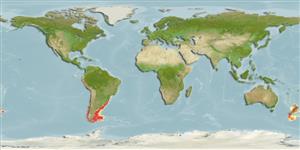Common names from other countries
Classification / Names / Names
Namen | Synonyme | Catalog of Fishes (gen., sp.) | ITIS | CoL | WoRMS
Environment: milieu / climate zone / depth range / distribution range
Ökologie
Bathydemersal. Tropical; 0°N - 90°S, 180°W - 180°E
Southeast Pacific and Southwest Atlantic: South America. Tropical to temperate.
Length at first maturity / Size / Gewicht / Alter
Maturity: Lm ? range ? - ? cm Max length : 260 cm TL Männchen/unbestimmt; (Ref. 1394); 220 cm TL (female); max. veröff. Gewicht: 350.0 kg (Ref. 1394); max. veröff. Gewicht: 350.0 kg
Found over the continental shelf and slope. Occurs in deep waters, and also venture into freshwaters in rivers and around glaciers. Feeds on many species of benthic and pelagic fishes, and invertebrates (i.e. lobster, krill, squid, octopus, and jellyfish), and occasionally penguins and young South American seals) (Ref. 1394). Preyed upon by a sevengill shark (Ref. 8910). Found over the continental shelf and slope. Occurs in deep waters, and also venture into freshwaters in rivers and around glaciers. Feeds on many species of benthic and pelagic fishes, and invertebrates (i.e. lobster, krill, squid, octopus, and jellyfish), and occasionally penguins and young South American seals) (Ref. 1394).
Jefferson, T.A., S. Leatherwood and M.A. Webber. 1993. (Ref. 1394)
IUCN Rote Liste Status (Ref. 130435)
CITES Status (Ref. 108899)
Not Evaluated
Nutzung durch Menschen
Fischereien: kommerziell
FAO - Fischereien: landings, Artbeschreibung | FishSource | Sea Around Us
Tools
Internet Quellen
Estimates based on models
Preferred temperature
(Ref.
115969): 6.3 - 15.6, mean 9.9 (based on 922 cells).
Widerstandsfähigkeit
hoch, Verdopplung der Population dauert weniger als 15 Monate. (K=0.31-0.31).
Verwundbarkeit
Moderate to high vulnerability (51 of 100).
Preiskategorie
Unknown.
